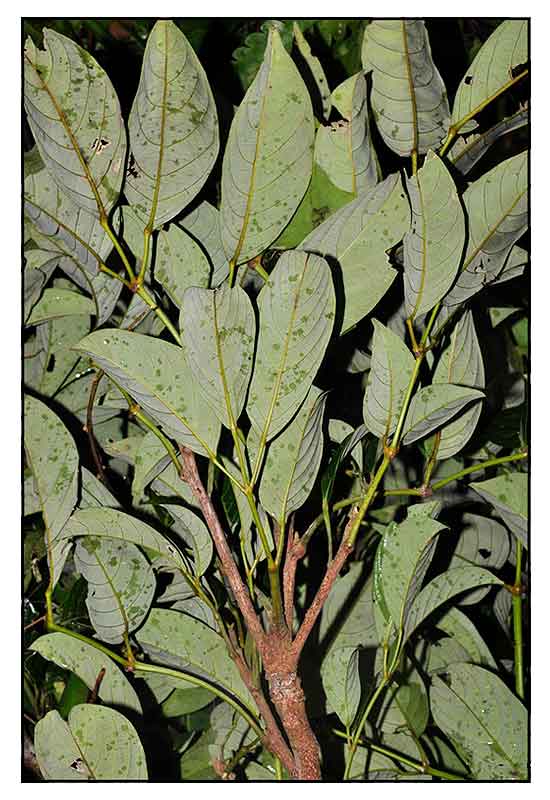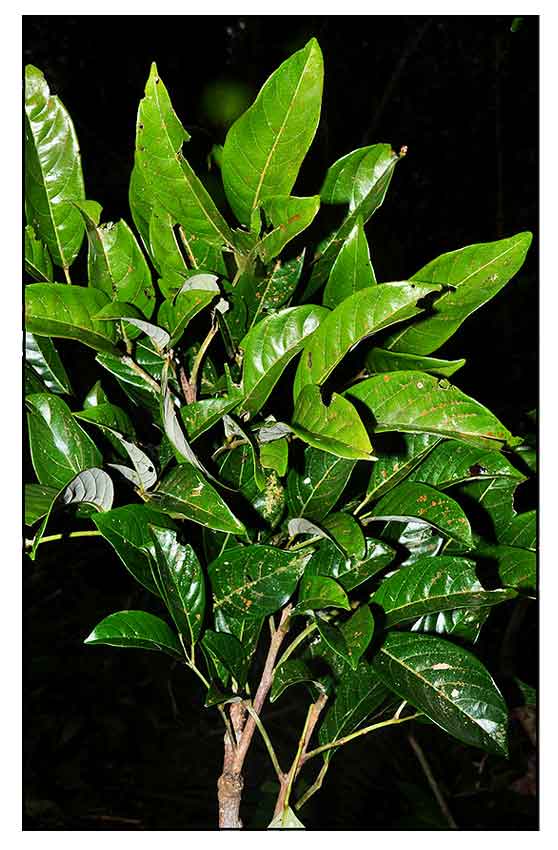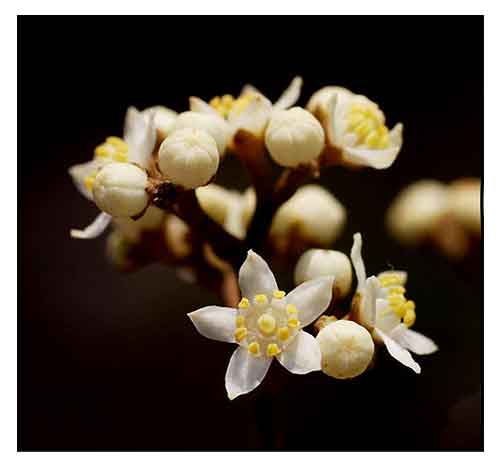 Gen info Gen info
- Etymology: Specific epithet pinnata is Latin, meaning "feather-like", referring to the leaves.
Botany
Walsura pinnata is a shrub to small tree, 1-4(-8) m tall. Bark grayish brown, with pale lenticels. Stem stout; branches many. Leaves odd- pinnate or reduced to a single leaflet, 15-20(-30) cm; petiole 1-7(-9) cm, ribbed; leaflets 1 or 3(or 5), opposite; petiolules of lateral leaflet blades 0.5-1.5 cm but terminal one 2-3.5 cm, with joints; leaflet blades ovate, ovate-lanceolate, or elliptic, (10-)14-18 × (3-)5-7 cm but terminal one largest, thickly papery to leathery, both surfaces glabrous, abaxially greenish white, adaxially green and lustrous, secondary veins 8-11 on each side of midvein and abaxially prominent, base attenuate to broadly cuneate, apex acuminate to acute. Panicles 1-6 cm, pubescent. Flowers 4-5 mm. Pedicel thin and slightly shorter than flowers. Calyx lobes triangular, outside pubescent, apex acuminate. Petals white, oblong to narrowly oblong, ca. 5 mm, abaxially pubescent, apex acute to acuminate. Stamen filaments broad, basal to middle part connate into a tube, ± pubescent, tip 2-lobed; anthers ovoid, inserted between 2 lobes of filament apex, apex acute. Disk red, cup-shaped to annular, glabrous. Ovary globose to oblate, flat, 2-locular, covered with thick trichomes; style cylindric; stigma disciform, tip 2-cleft. Berry globose to ovoid, ca. 1.5 cm in diam., densely covered with yellowish gray trichomes, with 1 or 2 seeds; exocarp thin; endocarp hard and leathery. (Flora of China) (3)
 Distribution Distribution
- Native to the Philippines.
- Common in forests at low and medium elevation.
- Also native to Andaman Is., Borneo, Cambodia, China, Hainan, Jawa, Laos, Malaya, Myanmar, New Guinea, Thailand, Vietnam.
(2)
Constituents
- Phytochemical study of bark isolated a new oleanane triterpene acid, 3-oxo-olean-9(11),12-dien-28-oic acid (1), together with nine known compounds, 3-oxo-olean11-en-28,13β-olide (2), 3β-hydroxy-5-glutinen-28-oic acid (3), betulonic acid (4), 3-oxo-20(24)-epoxy-12β,25- dihydroxydammarane (5), 2(3),6(7)-diepoxy-9-humulene (6), stigmasterol (7), daucosterol (8), vanillic acid (9), and 4-hydroxy-4,8-dimethyl-1-tetralone (10). (see study below) (4)
- Chromatographic isolation of n-hexane extract of stem bark isolated nine chemical constituents. Structures were characterized as ledol, oplopanone, betulonic acid, oleanonic acid, 3-oxoolean-11-en- 13β(28)-olide, 12α-hydroxy-3-oxooleanano-28,13-lactone, 3-oxoursolic acid, 3-ketours-11-en-13β(28)-olide, 3β-hydroxy-5-glutinen-28-oic acid.
(see study below) (6)
Properties
- Bark (rich in tannin) is astringent.
-
Studies have suggest cytotoxic, anticancer properties.
Parts used
Bark, fruits.
Uses
Edibility
- Fruit is edible, succulent and sweet tasting.
Folkloric
- No reported folkloric medicinal use in the Philippines.
- Decoction of bark and fruits used for treatment of diarrhea and dysentery.
Others
- Wood: Wood is yellow, hard and durable; used for construction.
 Studies Studies
• Anticancer / Bark: Phytochemical study of bark isolated a new oleanane triterpene acid, 3-oxo-olean-9(11),12-dien-28-oic acid (1), together with nine known compounds (2-10). Compounds 3 and 4 showed in-vitro growth inhibitory activity against two human cancer cell lines, MCF-7 and SK-OV-3, with IC50s in the range of 8.85-18.28 µg/mL. (see constituents above) (4)
• Pinnatane A / Cytotoxic against Human Liver Cancer Cells / Bark: Pinnatane A, isolated from the bark of Walsura pinnata, was investigated by MTT assay for anti-cancer properties by analyzing cytotoxic activities and cell cycle arrest mechanism induced in two different liver cancer cell lines. MTT assay identified pinnatane A prominent dose- and time-dependent cytotoxicity effects in Hep3B and HepG2 cells, with minimal effect on normal cells. Live/dead assay showed significant cell death, while cell cycle analysis showed arrest at G0/G1 phase in both cell lines. Annexin flow cytometry and DNA fragmentation assays identified apoptotic cell death in Hep3B and necrotic cell death in HepG2 cell lines. Results suggest potential for development as chemotherapeutic agent. (5)
• Cytotoxicity against Human Cancer Cell Lines / Stem Bark: Study of n-hexane extract of stem bark isolated nine chemical constituents. Betulonic acid and 3β-hydroxy-5-glutinen-28-oic acid were found to be cytotoxic against a series of human cancer cell lines with an IC50 of 19 μM, 18 μM on HepG2; 12 μM, 25 μM on MCF-7 and 13 μM, 21 μM on HSC-2 respectively. (see constituents above) (6)
• Betulonic Acid / Induction of Apoptosis in Leukemia Stem Cells / Bark: Study evaluated betulonic acid isolated from the bark of Walsura pinnata for pro-apoptotic effects in leukemia stem cells (LSC) in vitro and in vivo. Results showed BA inhibited the proliferative and cologenic properties of LSC. BA induced apoptosis in LSC through the mitochondria pathway and was effective in the in vivo zebrafish model. Results suggest BA can be a lead compound for development of a chemotherapeutic agent against LSC. (7)
• Walsucochins / Neuroprotective against H2O2-Induced PC12 Cell Damage: Study isolated Walsucochins A and B from Walsura cochinchinensis. Both exhibited significant cell protecting activities against H2O2-induced PC12 cell damage. (8)
Availability
Wild-crafted.
|

![]()






